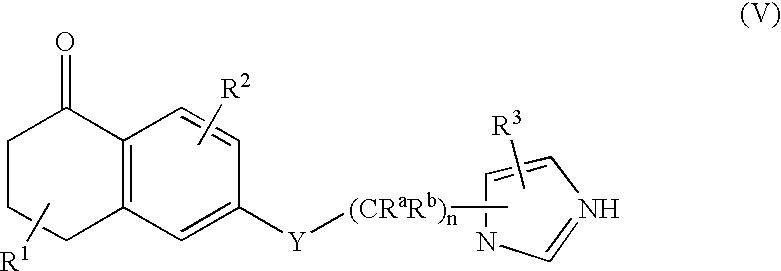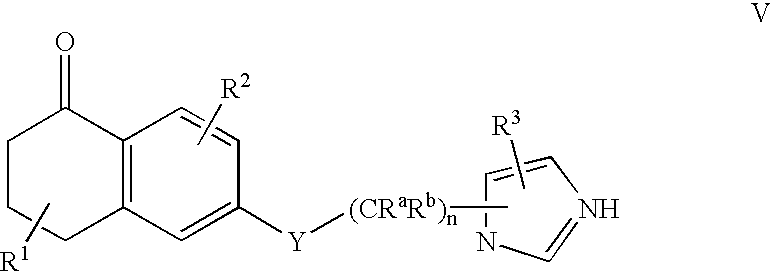Dihydro-2h-napthalene-1-one inhibitors of ras farnesyl transferase
a technology of ras farnesyl transferase and dihydro-2h-napthalene, which is applied in the direction of biocide, drug composition, cardiovascular disorder, etc., can solve the problems of uncontrolled cellular proliferation, deficiency of feedback regulation of proteins, and various surgical revascularization techniques
- Summary
- Abstract
- Description
- Claims
- Application Information
AI Technical Summary
Benefits of technology
Problems solved by technology
Method used
Image
Examples
example 2
[0158] Synthesis of 6-[2-(3-benzyl-3H-imidazol-4-yl)-ethoxy]-5-propyl-3,4--dihydro-2H-naphthalen-1-one (Compound 2)
[0159] 1. (1H-Imidazol-4-yl)-acetic Acid Ethyl Ester 60
[0160] 4-Imidazole acetic acid hydrochloride (5 g, 0.03 mol) is dissolved in methanol (100 mL) and the solution is saturated with dry HCl. The reaction is stirred overnight at room temperature under a nitrogen atmosphere. The solution is concentrated in vacuo and the residue dried to give the product (5.13 g, 0.029 mol).
[0161] 2. (1-Trityl-1H-imidazol-4-yl)-acetic Acid Ethyl Ester 61
[0162] The product from step 1, (1H-imidazol-4-yl)-acetic acid ethyl ester, (5.13 g, 0.029 mol) is suspended in dimethylformamide (25 mL) and triethylamine (12.5 mL, 0.09 mol) is added followed by chlorotriphenyl methane (9.88 g, 0.036 mol). The suspension is stirred overnight at room temperature under a nitrogen atmosphere. Ethyl acetate (250 mL) is added to the reaction mixture followed by water (100 .mu.L). The organic phase is collec...
example 3
[0173] Synthesis of 6-[2-(3-benzyl-3H-imidazol-4-yl)-ethoxy]-5-phenethyl-3-,4-dihydro-2H-naphthalen-1-one (Compound 3)
[0174] 1. 6-Methoxy-5-phenylethynyl-3,4-dihydro-2H-naphthalen-1-one 66
[0175] 5-Bromo-6-methoxy-.alpha.-tetralone, prepared as described U.S. Pat. No. 4,618,683 Example 89, (20.41 g, 0.08 mol) is added to a mixture of dimethylformamide (160 mL) and triethylamine (80 mL) which has been purged with nitrogen gas to remove dissolved oxygen. This is followed by the addition of phenylacetylene (16.34 g, 0.16 mol), copper(I)iodide (0.5 g, 0.0026 mol), and dichlorobis(triphenylphosphine)palladium(II) (Aldrich Chemical Company; 2.24 g, 0.0026 mol). After stirring at 25.degree. C. for 20 minutes, the mixture is heated to 108.degree. C. for 2 hours. At that time, an additional amount of phenylacetylene is added (31 g, 0.303 mol) dropwise over 2 hours, followed by heating at 108.degree. C. for 16 hours. The mixture is then evaporated in vacuo to remove solvent and excess reagent ...
example 4
[0186] Synthesis of 4-({5-[2-({5-oxo-1-[(2-pyridinylsulfonyl)methyl]-5,6,7-,8-tetrahydro-2-naphthalenyl}oxy)ethyl]-1H-imidazol-1-yl}methyl)benzonitri-le (Compound 28)
[0187] 1. 4-{[5-(2-Hydroxyethyl)-1H-imidazol-1-yl]methyl}benzonitrile 70
[0188] A mixture of 1-(triphenylmethyl)-4-(2-hydroxyethyl)imidazole (13 g, 36.7 mmol) [C. R. Ganellin et al., J. Med. Chem., 1996, 39, 3806] and 4-(bromo-methyl)benzonitrile (8.6 g, 44 mmol) in 100 mL of acetonitrile was heated under reflux for 2 days, and the solvent was removed under vacuum. The residue was then triturated twice with ethyl acetate, and the organic layer was discarded. The resulting residue was then dissolved in 100 mL of methanol and heated under reflux for 24 hours. The methanol was then removed under vacuum and the product was dissolved in 100 ml of 2M HCl. After being filtered to remove triphenylmethanol, the solution was made basic with NH.sub.4OH, and the product was extracted into CH.sub.2Cl.sub.2 to give 2.24 g of a crude o...
PUM
| Property | Measurement | Unit |
|---|---|---|
| Fraction | aaaaa | aaaaa |
| Mass | aaaaa | aaaaa |
| Mass | aaaaa | aaaaa |
Abstract
Description
Claims
Application Information
 Login to View More
Login to View More - R&D
- Intellectual Property
- Life Sciences
- Materials
- Tech Scout
- Unparalleled Data Quality
- Higher Quality Content
- 60% Fewer Hallucinations
Browse by: Latest US Patents, China's latest patents, Technical Efficacy Thesaurus, Application Domain, Technology Topic, Popular Technical Reports.
© 2025 PatSnap. All rights reserved.Legal|Privacy policy|Modern Slavery Act Transparency Statement|Sitemap|About US| Contact US: help@patsnap.com



